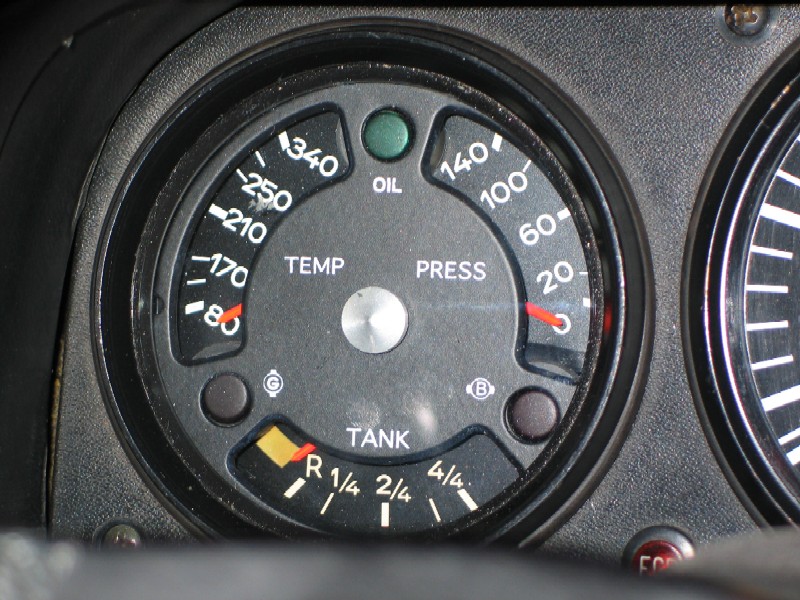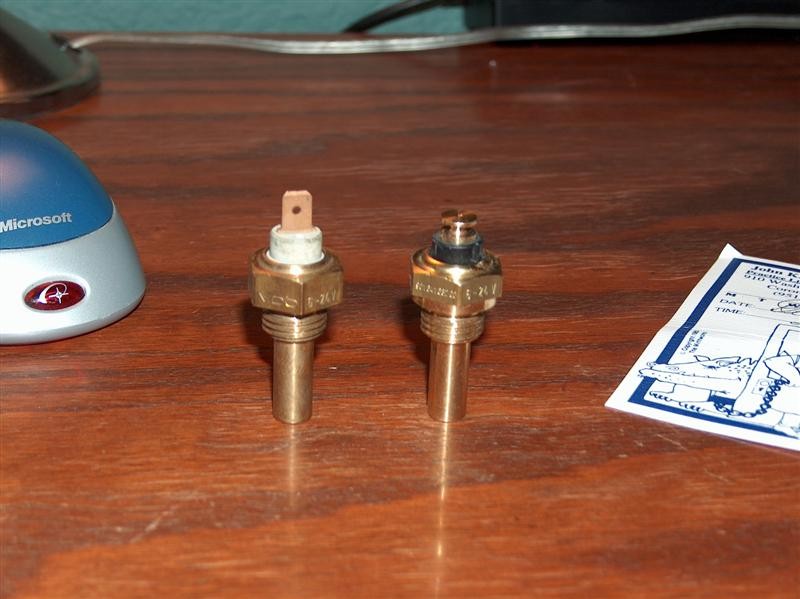Printable Version of Topic
Click here to view this topic in its original format
914World.com _ 914World Garage _ Oil Temp sender...
Posted by: jim_hoyland Jan 19 2006, 09:50 PM
Finally installed a 911 oil temp sender to replace the original VDO that connected to the center console VDO gauge. It is wired to the 904 combo gauge.
The gas tank and oil pressure work fine. The oil temp isn't moving unless you ground the wire, which pegs the gauge. I assume that means the gauge works.
Now that the911 ( PPpart # 901-641-632-00-M100) is installed, I want to know whether I can test the sender while it's still in the engine ??
Any help will be appreciated
Attached image(s)
Posted by: jim_hoyland Jan 19 2006, 10:40 PM
The original sender on the left has the spade connector; the new one that is wired to the 904 gauge is on the right....
Attached image(s)
Posted by: Aaron Cox Jan 19 2006, 10:42 PM
| QUOTE (jim_hoyland @ Jan 19 2006, 09:40 PM) |
| The original sender on the left has the spade connector; the new one that is wired to the 904 gauge is on the right.... |
one on the left is a 914 sender, one on right is 911 early sender (for numbered gauge as seen above)
Posted by: jim_hoyland Jan 19 2006, 10:49 PM
I need to find out why that sender doesn't register at the gauge. Hmmmmm...........................................
Posted by: Spoke Jan 20 2006, 06:03 AM
I just installed an oil temp gauge and tested the gauge and sender on the bench by connecting the items under power and heating the sender with a propane torch. This isn't an accurate test but just shows that the sender and gauge are ok.
To debug your system, get a low ohm potentiometer (maybe 50, 100, 150 ohms) from Radio Shack or other electronics store, and connect this to your gauge to ground. At some resistance setting, your gauge will respond smoothly. If the ohms of the potentiometer are too high, you'll notice that the gauge only reacts near the end of the potentiometer adjustment range. If the resistance of the pot is too low, the gauge will never go to zero. Find a setting that gives a good deflection on the gauge, then disconnect the potentiometer, and with a multimeter, measure the resistance.
After that, measure the resistance of your sender. Heat the sender up with either hot water or a torch (move torch around for even heating and don't get too close to the unit). At some temperature, the resistance of the sender should be close to the resistance of the potentiometer.
If the sender is in the car, try measuring the resistance of the sender to ground. One would think that the sender in the engine would be grounded but stranger things have happened. Do this with the car hot and cold.
I did notice that the oil temp gauge on my car responds very slowly since the oil heats up slowly, much slower than the CHT. On the first recon drive to test the oil gauge, I thought is was not working until about 10 minutes into my drive when I finally got some deflection.
Good luck,
Spoke
Posted by: Dave_Darling Jan 20 2006, 01:09 PM
The temp sender is a thermistor--a resistor that changes resistance with heat. One side of the thermistor is the wire connection, the other is the threads which presumably connect with a ground (like the crankcase). Check the resistance between the wire connection and a ground. Or between a wire connected to the wire connection on the sender, and a ground.
Infinite resistance either means you don't have the wire actually connected to the sender, or the sender is dead. Or you don't have a connection from the sender to a ground.
--DD
Posted by: jim_hoyland Jan 20 2006, 02:16 PM
Thanks Dave. What's the best way to just test the gauge--by grounding to see if the needle jumps ?
Posted by: Spoke Jan 20 2006, 02:23 PM
| QUOTE (jim_hoyland @ Jan 20 2006, 03:16 PM) |
| Thanks Dave. What's the best way to just test the gauge--by grounding to see if the needle jumps ? |
Potentiometer (of the right ohms) from gauge to ground will simulate the sender. By adjusting the pot you should see smooth operation of the needle. Your grounding of the wire is the same as a pot adjusted to minimum ohms.
Spoke
Posted by: jim_hoyland Jan 20 2006, 02:26 PM
Will try tomorrow; thanks for the tips.
Posted by: Dave_Darling Jan 20 2006, 07:55 PM
Grounding the wire will serve as a "quick and dirty" test, as well. Chances are the gauge is ok (or at least will read something!) if it is zero with the wire disconnected and pegs to maximum when you ground the wire.
--DD
Powered by Invision Power Board (http://www.invisionboard.com)
© Invision Power Services (http://www.invisionpower.com)